
Question Number 209162 by dr1001sa last updated on 02/Jul/24
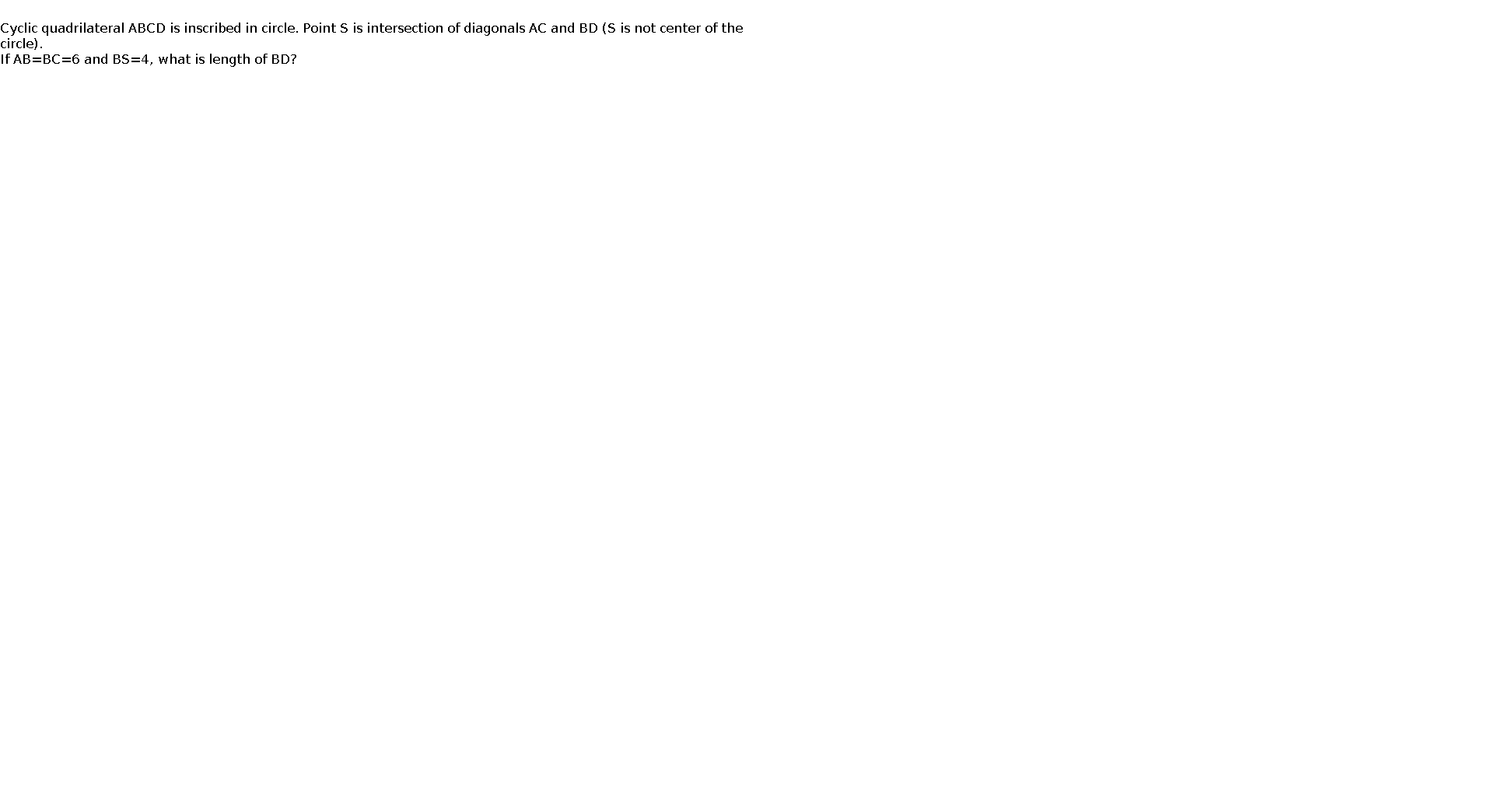
$$ \\ $$Cyclic quadrilateral ABCD is inscribed in circle. Point S is intersection of diagonals AC and BD (S is not center of the circle). If AB=BC=6 and BS=4, what is length of BD?
Answered by mr W last updated on 02/Jul/24
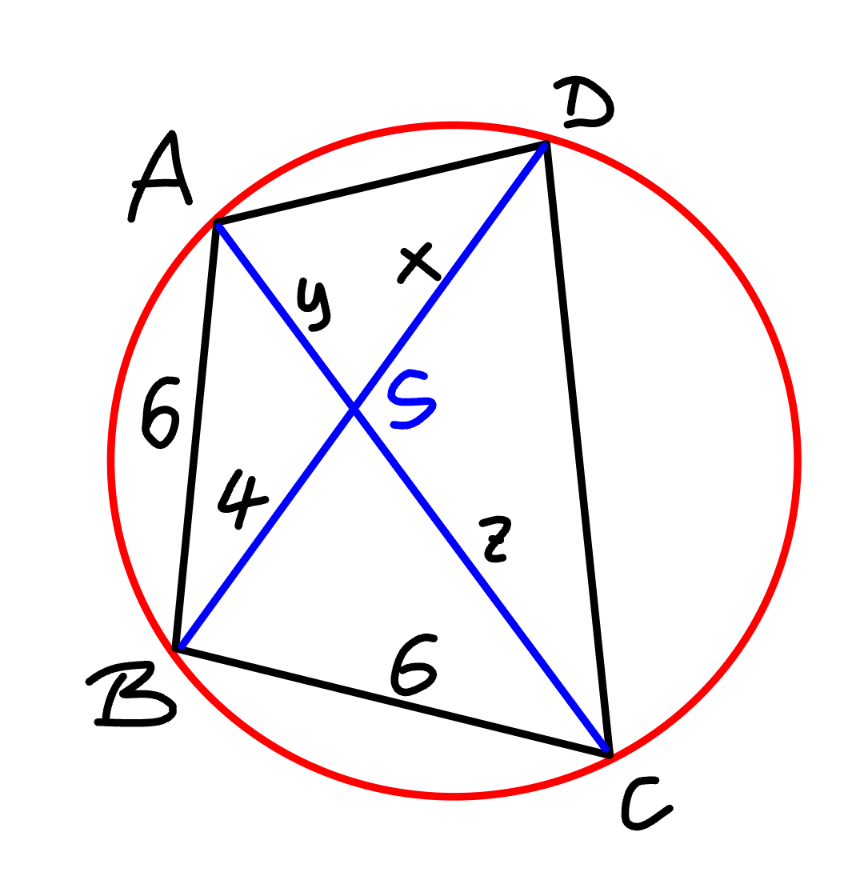
Commented by mr W last updated on 03/Jul/24
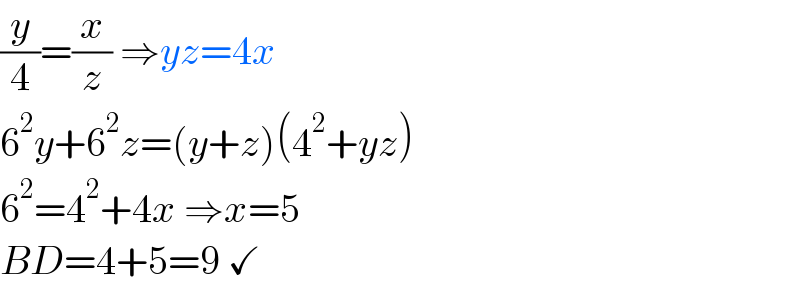
$$\frac{{y}}{\mathrm{4}}=\frac{{x}}{{z}}\:\Rightarrow{yz}=\mathrm{4}{x} \\ $$$$\mathrm{6}^{\mathrm{2}} {y}+\mathrm{6}^{\mathrm{2}} {z}=\left({y}+{z}\right)\left(\mathrm{4}^{\mathrm{2}} +{yz}\right) \\ $$$$\mathrm{6}^{\mathrm{2}} =\mathrm{4}^{\mathrm{2}} +\mathrm{4}{x}\:\Rightarrow{x}=\mathrm{5}\: \\ $$$${BD}=\mathrm{4}+\mathrm{5}=\mathrm{9}\:\checkmark \\ $$
Commented by efronzo1 last updated on 03/Jul/24

$$\:\:\left(\mathrm{i}\right)\: \mathrm{x}\:=\: \\ $$$$ \left(\mathrm{ii}\right)\: \theta\:=\frac{\mathrm{y}^{\mathrm{2}} −\mathrm{20}}{\mathrm{8y}} \\ $$$$\:\:\:\:\:\:\:\:\: \left(\mathrm{180}°−\theta\right)\:=\:\frac{\mathrm{z}^{\mathrm{2}} −\mathrm{20}}{\mathrm{8z}} \\ $$$$\:\:\:\:\:\:\:\:\:\frac{\mathrm{20}−\mathrm{y}^{\mathrm{2}} }{\mathrm{8y}}\:=\:\frac{\mathrm{z}^{\mathrm{2}} −\mathrm{20}}{\mathrm{8z}} \\ $$$$\:\:\:\:\:\:\:\mathrm{20}\left(\mathrm{z}+\mathrm{y}\right)\:=\:\mathrm{yz}\left(\mathrm{z}+\mathrm{y}\right) \\ $$$$\:\:\:\:\:\:\:\:\mathrm{yz}\:=\:\mathrm{20}=\:\mathrm{4x}\: \\ $$$$\:\:\:\:\:\:\:\:\mathrm{x}\:=\:\mathrm{5}\: \\ $$$$\:\:\:\:\:\: \\ $$
Commented by dr1001sa last updated on 03/Jul/24

$${which}\:{theorem}\:{u}\:{use} \\ $$
Commented by mr W last updated on 03/Jul/24
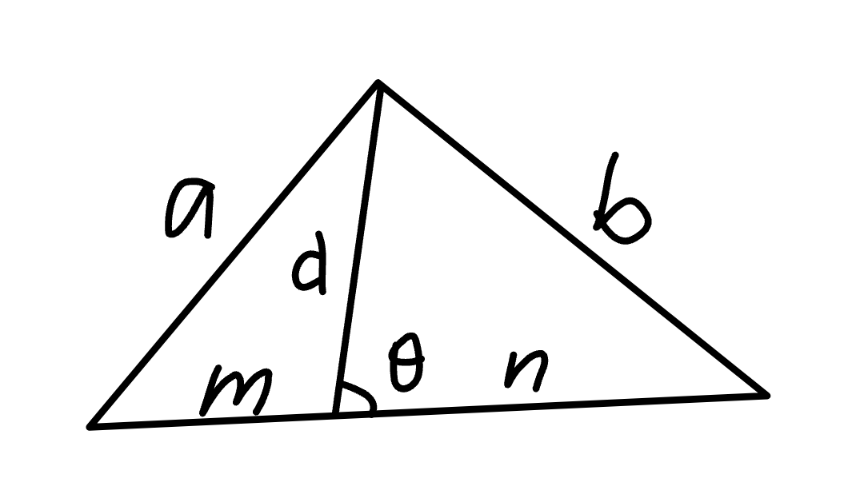
Commented by mr W last updated on 03/Jul/24
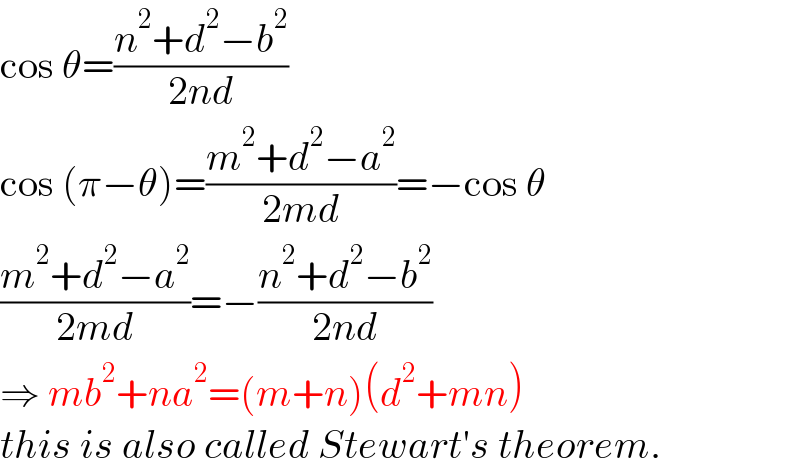
$$\mathrm{cos}\:\theta=\frac{{n}^{\mathrm{2}} +{d}^{\mathrm{2}} −{b}^{\mathrm{2}} }{\mathrm{2}{nd}} \\ $$$$\mathrm{cos}\:\left(\pi−\theta\right)=\frac{{m}^{\mathrm{2}} +{d}^{\mathrm{2}} −{a}^{\mathrm{2}} }{\mathrm{2}{md}}=−\mathrm{cos}\:\theta \\ $$$$\frac{{m}^{\mathrm{2}} +{d}^{\mathrm{2}} −{a}^{\mathrm{2}} }{\mathrm{2}{md}}=−\frac{{n}^{\mathrm{2}} +{d}^{\mathrm{2}} −{b}^{\mathrm{2}} }{\mathrm{2}{nd}} \\ $$$$\Rightarrow\:{mb}^{\mathrm{2}} +{na}^{\mathrm{2}} =\left({m}+{n}\right)\left({d}^{\mathrm{2}} +{mn}\right) \\ $$$${this}\:{is}\:{also}\:{called}\:{Stewart}'{s}\:{theorem}. \\ $$
Commented by dr1001sa last updated on 03/Jul/24

$${thank}\:{you}\:{so}\:{much} \\ $$
Answered by A5T last updated on 02/Jul/24
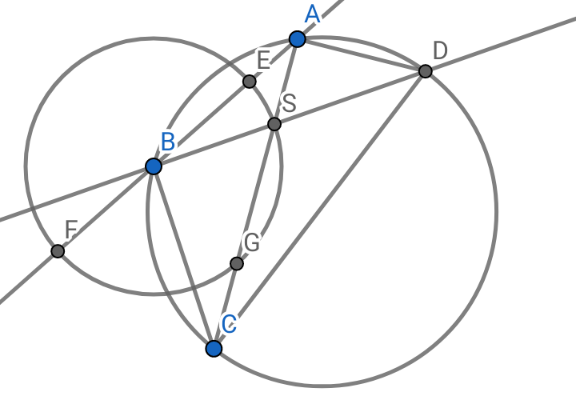
Commented by A5T last updated on 02/Jul/24

$${Consider}\:{circle}\:{centered}\:{at}\:{B}\:{with}\:{radius}\:\mathrm{4} \\ $$$$\Rightarrow{AE}×{AF}={AS}×{AG}={AS}×{SC}={BS}×{SD} \\ $$$${AE}={AB}−{BE}=\mathrm{6}−\mathrm{4}=\mathrm{2};{AF}={AE}+\mathrm{2}×\mathrm{4}=\mathrm{10} \\ $$$$\Rightarrow{AS}×{AG}=\mathrm{2}×\mathrm{10}=\mathrm{20}={BS}×{SD}=\mathrm{4}×{SD} \\ $$$$\Rightarrow{SD}=\frac{\mathrm{20}}{\mathrm{4}}=\mathrm{5}\Rightarrow{BD}={BS}+{SD}=\mathrm{5}+\mathrm{4}=\mathrm{9} \\ $$
